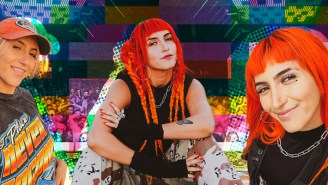Last weekend, millions took to the pavement as cities around the nation hosted Women’s Marches and peaceful protests. It was stunning to see the images of the hundreds of thousands of people, crowding the streets, chanting and holding signs. Already, the day has gone down in history as the largest protest our country has ever known.
For many young people, Saturday’s march and 2016’s Black Lives Matter rallies have offered an intro-course to the power of resistance. But for older participants, the sight may have been all too familiar. One popular sign from the rallies was, “I can’t believe I’m still fighting this shit.”
Looking at history, it’s clear that our ability and right to protest is an important part of our American heritage. And given the current political flux, the new photography exhibition at the Bronx Documentary Center entitled, “Whose Streets? Our Streets! New York City: 1980-2000” couldn’t be more fitting.
The show includes images from 38 different photographers, exhibited together for the first time. They chronicle the protests and social movements that took place in New York from 1980-2000. It’s a powerful collection — one that feels rich with history and incredibly urgent at the same time.
While a reminder of how social movements are intertwined with acts of civil disobedience always seems relevant, the exhibit feels particularly important in the early days of 2017. Though this connection between the current protests and the installation wasn’t the original plan. The idea actually came in 2014, when Tamar Carroll — a historian and co-curator of Whose Streets? Our Streets! — began looking for photographs for a new book she was writing.
“I was contacting photographers to license photographs to use in my book, which is called “Mobilizing New York AIDS, Anti-Poverty, and Feminist Activism,” Carroll says. “I reached out to Meg Handler because she had taken some really powerful photographs of protesters at ACT UP demonstrations. It’s the AIDS Coalition to Unleash Power. Meg and I started corresponding, and she was like, “You know, Tamar, this would make a fabulous exhibit.”
Handler was immediately on board.
“We started these conversations about who photographed what, and what she was looking for and, we just got inspired and thought, wow, I think this is a photo exhibition,” the photographer/ photo editor explains. “And I thought, the Bronx Documentary Center, being that it’s a community non-profit space in an under-served neighborhood, not a commercial gallery, would be the perfect place to have it. So, we pitched it directly to BDC, and it’s the only place we pitched it to, and they accepted it.”
“We thought this was the right place because of their location in the South Bronx, and their community focus,” Carroll adds. “And the way they bring in, for example, school children from the South Bronx to see exhibits. We really wanted to get this material in front of as diverse and audience as possible.”
Over the next few years, Carroll and Handler worked on putting together the exhibit. Then the election came and the results completely shocked them.
“The opening was scheduled for the week before the inaugural and I think in the back of our minds we thought we’d be celebrating the first female president,” Handler says. “There was an assumption on all of our parts that ‘we’ll do this before the inaugural, it’ll be great, it’ll be an inspiration,’ and ‘look at how much we’ve accomplished.’ A lot of the issues we’re still fighting for, but there was some great change that happened with, you know, issues involving people with AIDS, and medication and some housing stuff got settled, some other housing stuff didn’t. But we did not see it as a call to action until after November 9th…You know, the election changed …” she pauses, “I don’t think it changed the tenor of the show, but I think it changed the purpose of the show. I think the purpose of the exhibition became something bigger than what we had expected….People are kind of amazed at how timely it is. But that’s just fate,” she said.
The show highlights several movements of the time — covering themes of race relations, police brutality, war and the environment, AIDS, queer activism, abortion rights, housing activism, education & labor, and the culture wars. Many of the photographs exhibited haven’t been presented in a public space before, and in that way, could have been lost history. In fact, Carroll and Handler decided to end the collection before 9/11 — to remain in an era when photos were still taken on film, and before social media changed the way we consume pictures and news.
It’s exciting to view the collection as a whole, as it tells the story of social movements in New York in a comprehensive way. Regardless of the subject of each particular protest, there are shared emotions. The stories being shared are visceral and sensory — as people rally together in the name of a common belief.
“People who commit acts of civil disobedience, and they’re willing to put their bodies on the line and to go to jail, they’re saying, ‘Hey, government, hey, fellow citizens, this issue is so important that I am willing to go to prison for it,’” Carroll says. “To me, that’s always been a really powerful political act as something I really respect deeply, and so I’m interested in that and also the way that people can create identities, and form communities through ongoing involvement, for example, like ACT UP. Many of their members protested together for years, and in fact still are. I saw a post from them on social media that they were traveling to Washington, or marching in New York City this past weekend.”
It’s also interesting to look at the effect that being part of one of these movements might have on its participants.
“I’m interested in the way that participating in protests can add to the power of social movements,” Carroll continues. “Both externally, through getting their message out, but also internally, how it can affect a sense of community and a sense of identity.”
Carroll also speaks about some of photographs in the exhibition that really struck her. One of which is a picture of a white man angrily holding up a watermelon at black protesters.
“Several young black men were killed by white mobs in the 80s and early 1990s,” she explains. “These were in neighborhoods where white residents wanted to maintain racial segregation, basically. What you’ll see in those photographs is Reverend Al Sharpton leading civil rights marches through those white neighborhoods, and white residents holding up watermelons and counter-demonstrating, using this racist iconography to taunt and to jeer at Reverend Al Sharpton and the other predominantly African-Americans who were marching with him in support of civil rights. Those are really … I think those are very important photographs to see.”
Racial tension is the subject of several of the photographs in the exhibit. Carroll highlights the Crown Heights riots as being one of the most significant race riots in New York’s recent history. And the power behind the photographs taken there.
“Those were race riots that were touched off when an Orthodox Jewish motorcade hit two young children from an immigrant family from Guyana, and killed one of the children and badly injured the other,” she said. “Then in the aftermath of the accident, there was dispute over which ambulance company would service who, the children versus the Orthodox Jewish Rabbi who was also taken to the hospital because he was in the crash. Anyway, that touched off three days of race riots. That’s often seen as a real low point in the city’s history of race relations. It’s not the only race riot, but it was a very significant one. Some of these are spontaneous eruptions rather than organized civil disobedience that are tied to a social movement with a long-term goal of creating social change.”
Some of the pieces in the exhibit are peaceful, while others are more violent, looking almost apocalyptic. And photographers often put themselves in harm’s way to get the shot. Carroll cites a few different protests that became dangerous for journalists and protesters alike.
During the Tomkins Square Park riots, the city wanted to close the park because of the homeless and drug addict population. They imposed a curfew and to enforce this rule, police encircled the park. Soon, violence broke out.
“Some of whom were just passer-bys,” Carroll says. “Some of whom were homeless people, some of whom were journalists, and they charged them and started swinging with batons, and then the crowd responded violently back. There were a lot of injuries and arrests. More than 100 complaints of police brutality were filed as a result of the Tompkins Square Park riots.”
Protests turned to riots out again in 1992, after police shot a man named Jose Kiko on a drug sweep. “There was a lot of unrest, including the burning … There’s a photograph by Ricky Flores of a car being burned,” Carroll explains. “There’s other photographs, I believe, of people picking up very large garbage cans, and the really big orange construction cones. Not the little ones, but really big ones, and throwing them at police and at journalists.”
Response to the exhibit has been overwhelmingly positive, a fact that Handler and Carroll are thrilled by.
“It’s been all positive,” Handler notes. “People are, I think, they’re moved by the very nature of the exhibit. I think that people connect to certain issues like gentrification, like police brutality, like reproductive rights. A lot of these issues we’re still dealing with today, so I think that there’s something to be learned from looking at how we functioned in these spaces in the past.”
But it’s even bigger than that. “I think, people are also pretty moved by just seeing people like them, like themselves,” Handler says. “On the street, you know, making noise, getting their voices heard.”






